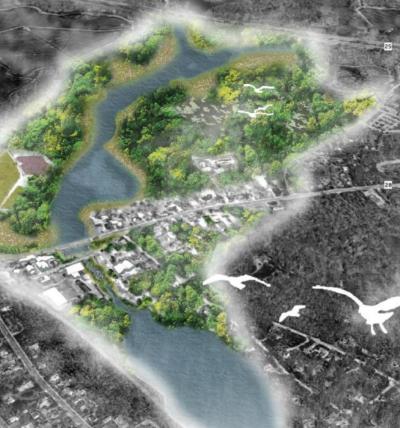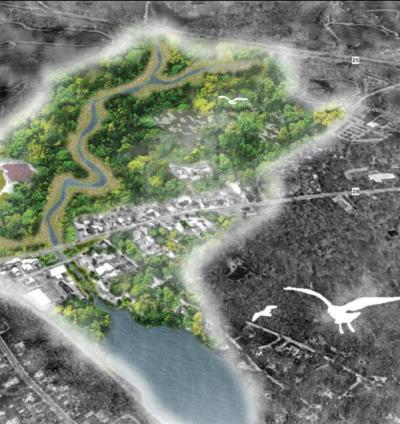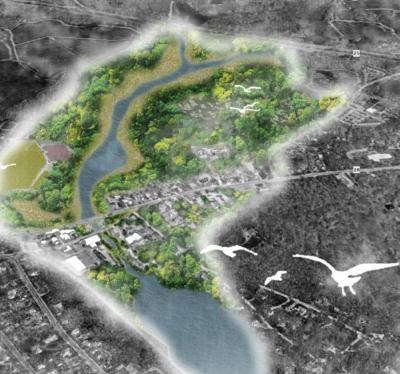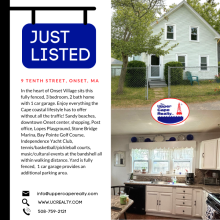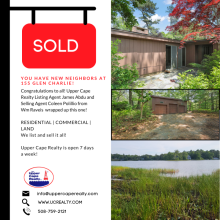About dam time: Town to choose between three Parker Mills revamps
The town of Wareham has three options to deal with the crumbling Parker Mills Dam, which has closed Elm Street near the Tremont Nail Factory for the better part of a decade.
The town can reduce the height of the 10-foot dam structure by 5 feet, remove the structure completely or do something in between.
These three alternatives, and their various pros and cons, were presented by the Fuss and O’Neill consulting firm to a Technical Advisory Committee consisting of town officials during a Zoom meeting on Thursday, Dec. 15.
The meeting was the third and final time that members of the public could learn and share their views about the Parker Mills Dam Assessment Project.
The Project is currently in its fifth and final phase, design and development. Previously, Fuss and O’Neill collected data, investigated the site of the existing dam and drafted ideas for what would happen to the old dam with the town’s feedback. The firm also created a “matrix” visualizing the positive and negative aspects of each alternative so that residents could compare and contrast them. The matrix judged the three alternatives based on their effect on water flow and fish habitat, ability to deter flooding, aesthetic appeal, historic character, cost and whether they could make the area surrounding the dam a center of business and pleasure for the community.
The first alternative, a “partial vertical removal,” would shorten the 10-foot dam structure by 5 feet. Replacing the dam’s current fishway would be a new fishway designed to look like part of the natural environment, blending into the scenery. However, smaller fish would have trouble navigating this steep, rocky fishway.
The partial vertical removal would provide a minimal reduction in flooding and have a minimal impact on local bridges. Flatwater kayaking would be possible, but kayakers would not be able to sail from one side of the dam to the other. Hiking trails may or may not be possible. It would also be the least expensive alternative, with a projected cost of $15 million over 10 years.
Whatever alternative is chosen, funding would come from grants and federal sources, especially NOAA and the Fish and Wildlife Service.
A “full vertical removal” would only remove the dam structure, not the entire dam embankment.
Full removal would improve waterfront access. Hiking, fishing and whitewater kayaking would be possible upstream, with flatwater kayaking taking place downstream.
This plan would leave Fuss and O’Neill with 5,000-10,000 cubic yards of sediment to deal with.
“That’s not necessarily a problem,” said Fuss and O’Neill environmental engineer Elsa Loehmann, “but it adds more to the situation.”
Full vertical removal would drastically reduce flooding, but would be the most expensive option, at a cost of $30 million over 20 years, and require the replacement of the bridges at Route 25, Harlow Brook and Tihonet Road.
The third option, a hybrid between full and partial removal, would improve fish passage and create less sediment than full removal. It would have a moderate impact on bridges and could result in the replacement of the Route 28 bridge. The cost would depend on the final design.
Another aspect of concern was the fate of the Old Company Store, which is built on timber piles and has stacked brick and masonry around it. Under partial dam removal, the Parker Mills Pond’s water level would be lower, exposing more of the piles.
“The problem with exposing timber piles is that when they’re underwater, they’re preserved,” Loehmann said. “When they’re exposed to the air, they start to deteriorate much more quickly.”
Additional support would be needed.
Under full dam removal, the water under the building would disappear, creating an opportunity to protect the piles.
At a Board of Selectmen meeting on Sept. 27 and a Technical Committee Advisory meeting on Nov. 7, both groups expressed support for “a long-term or phased approach to eventual full removal of the dam.” This will take several years and require further study. Fuss and O’Neill plans to do an analysis of coastal and river flooding depending on what alternative it will build.
Loehmann said that she thought Fuss and O’Neill would already have a plan to submit for permits.
“There were a lot of different things that needed different analysis,” she said.
Loehmann said that residents’ property taxes would not go up if they lived near the construction sight, but if a deed contradicts a property line, it would have to go into evaluation.
“The property lines are well defined,” she said. “It should not have an impact on taxes. Do not kick me later if that proves to be incorrect.”
Fuss and O’Neill is looking for public opinion on the proposed dam alternatives until Jan. 5. Residents can fill out an online survey at https://forms.office.com/r/i5MK7uQ1p8 and email CZakas@fando.com and ELoehmann@fando.com with questions and comments about the project.
More information about the project is available at https://bit.ly/ParkermillsDam



